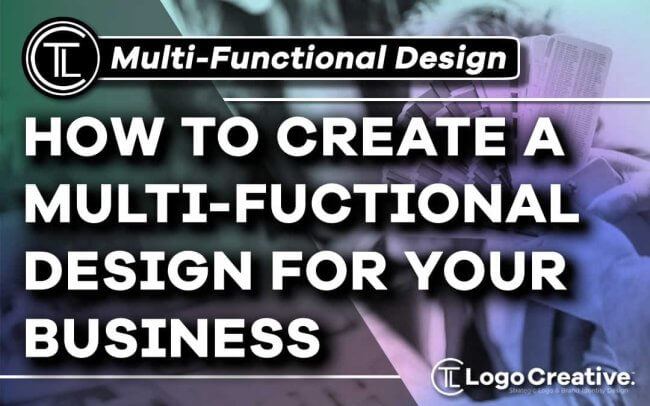Whether your business is up for a rebrand or you need to make a new update, these changes can often occur in your company. That’s why it’s essential to ensure your designs adhere to versatility. A multi-functional design can save time and maintain consistency for your brand. In this article we discuss How to Create a Multi-Functional Design for Your Business.
For instance, a primary branding color should be something recognizable yet reproducible in a variety of ways and contexts.
Whether you’re printing a business card or creating a digital ad, you want to ensure your design is useful in many situations and channels. So here are a few helpful tips for creating a multi-functional design for your business.
Table of Contents
1. Keep the Design Clean
Most of the time, simple is best. When you want to implement versatility, a clean design will give you more options. Avoid being too complicated with your overall design, especially if your brand isn’t well established yet.
When your business is newer, your branding will change over time. Yet, keeping a simple design is a great way to prevent more changes later on. With basic typography and a simple layout, you can keep things fresh for many years to come.
When creating a new design, ask yourself if the graphic looks too overcrowded. The most straightforward method to keeping a design clean is by taking away unnecessary elements.
2. Add Some Contrast
Adding contrast is one of the main principles of creating a multi-functional design. For one, it carries out a visual hierarchy and an organized structure. Contrast signals with which parts of the design your audience should focus on. It adds visual interest, captures attention, and prevents the layout from looking dull.
When applying contrast, you want to be sure the design is harmonious. Adding too much difference can be confusing and unappealing to viewers.
To create a multi-functional design, adding contrast is the perfect way to go. Here are a few ways to implement contrast within a design:
- Size
- Color
- Alignment
- Repetition
- Proximity
- Whitespace
- Texture
One option when it comes to printing materials is to consider the color of the paper. When you’re adding contrast with the background color, this may not be easy to design on screen. Because colors can turn out differently when printing, you can still add contrast by printing with colored paper.
Furthermore, you can continue to play around with lighter and darker shades when working with color contrast. Messing around with light and dark colors is one of the easiest ways to add contrast to your design.
For example, if you’re using a photo with a dark background, bright white typography makes for excellent color contrast.
3. Include High-Resolution and Vector Images
When you’re printing a design, a successful print will have a high-resolution asset. We want to make sure your printed image looks great because a high-resolution photo of something like a gift card can often lead to referrals and retention for your business.
However, if you’re rushing to find a last-minute image, you often end up with a free image you found on the web with 72 dpi. Sure, it looks great on the screen, but when it comes time to print, you’ll notice a vast difference in quality.
The solution for this is to use high-resolution raster or vector artwork:
- High-resolution images have tiny pixels, and the more pixels there are per inch, the more precise the image will be. For printing materials, the standard resolution should be 300 dpi. The image will look amazing at 100% but will pixelate when you start to zoom in. That’s why an image at 72 dpi will almost always look subpar in print.
- Vector images come from a mathematical calculation which means there are no pixels but numbers. Vector images work best with solid colors and illustrations. They look great whether they’re on a business card or a giant billboard.
So keep these factors in mind when you’re in a hurry to find an image. Ask yourself if the artwork is high enough resolution. Would it be crisp enough if you were to put it on a card, a banner, or even a poster?
4. Limit the Number of Fonts and Play With Font Size
When using a simple design tool like Canva, you might feel tempted to use all the pretty fonts to make your design stand out. However, using too many fonts is something you should try to avoid.
Although it can be challenging to limit yourself, the standard recommendation is to use two fonts at most. You also want to make sure they pair well with each other and that the fonts fit within your branding guidelines. Limiting the number of fonts can be a good thing since it’s great for readability and keeping things consistent.
However, if you want to play around with your visuals, font sizes can create a distinct effect on the overall layout. You can use a larger font to emphasize a message and pair it with a smaller font to go into more detail.
5. Establish Branding Guidelines
If you want to create a multi-functional design for your business, establish a set of branding guidelines first. While branding guidelines make the design more manageable, they also keep things uniform.
To establish branding guidelines, ensure you incorporate a color palette, logo, typography, and other branding elements.
Overall, guidelines can keep your brand’s presence unified and cohesive across your communication and marketing channels.
Make Your Design a Success
Design plays a critical role in the prosperity of your business. Additionally, you want to be mindful of the details because they matter when making a multi-functional design. When you create a successful design with versatility, you’re providing an asset for your business.
Join The Logo Community
We hope you enjoyed How to Create a Multi-Functional Design for Your Business.
If you would like more personal tips, advice, insights, and access to our community threads and other goodies, join us in our community.
You can comment directly on posts, access our community threads, have a discussion and ask questions with our founder Andrew.
If you’re looking to learn more about brand strategy, we highly recommend eRESONAID with our friend and acclaimed brand strategist and author Fabian Geyrhalter, it’s packed full of knowledge and insights you will need to learn to become a brand strategist or apply what you learn within your own business.
 Author Bio
Author Bio
Eleanor Hecks is editor-in-chief at Designerly Magazine. She was the creative director at a prominent digital marketing agency prior to becoming a full-time freelance designer. Eleanor lives in Philadelphia with her husband and pup, Bear.


